Yakshini
| Yakshini | |
|---|---|
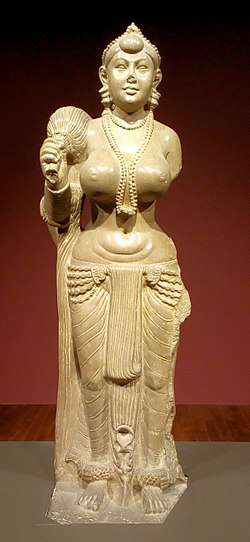 | |
| Affiliation | Devi |
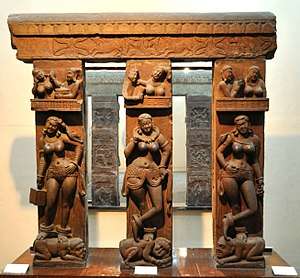
Yakshini (also known as Yakshi; Yakkhini in Pali) are mythical beings of Hindu, Buddhist, and Jain mythology. Yakshini (Yakshi) is the female counterpart of the male Yaksha, and they are attendees of Kubera, the Hindu god of wealth who rules in the mythical Himalayan kingdom of Alaka. Yakshinis are often depicted as beautiful and voluptuous, with a chauri (fly-whisk) in right hand, fleshy cheeks, with wide hips, narrow waists, broad shoulders, knotted hair and exaggerated, spherical breasts. In Uddamareshvara Tantra, thirty-six Yakshinis are described, including their mantras and ritual prescriptions. A similar list of Yakshas and Yakshinis are given in the Tantraraja Tantra, where it says that these beings are givers of whatever is desired. Although Yakshinis are usually benevolent, there are also yakshinis with malevolent characteristics in Indian folklore.[3] They are the guardians of the treasure hidden in the earth.
36 Yakshinis
The list of thirty six yakshinis given in the Uddamareshvara Tantra is as follows:[3]
- Vichitra (The Lovely One): She bestows all desires.
- Vibhrama (Amorous One)
- Hamsi (The one with Swan): She reveals the whereabouts of buried treasure, and grants an unguent with which one may see through solid objects.
- Bhishani (The Terrifying): The ritual is to be performed at the junction of 3 paths. The mantra is to be recited 10,000 times. Camphor and ghee are to be used as the offering. Om Aim Drim Mahamode Bhishani Dram Dram Svaha.
- Janaranjika (Delighting Men): She gives great good fortune and happiness.
- Vishala (Large Eyed): She gives the alchemical elixir.
- Madana (Lustful): She gives a cure-all pill.
- Ghanta (Bell): She gives the ability to enchant the world.
- Kalakarni (Ears Adorned with Kalas):
- Mahabhaya (Greatly Fearful): Protection from disease. She gives freedom from fear and the secret of alchemy, also freeing one from grey hair and signs of old age.
- Mahendri (Greatly Powerful): Gives the person the ability to fly and go anywhere.One obtains Patala Siddhi.
- Shankhini (Conch Girl ): Fulfilment of any desire.
- Chandri (Moon Girl):
- Shmashana (Cremation Ground Girl ): She gives treasure, destroys obstacles, and one is able to paralyse folk with a mere glance.
- Vatayakshini: She also gives a divine and magical unguent.
- Mekhala (Love Girdle):
- Vikala: She yields the desired fruit.
- Lakshmi (Wealth): She gives Lakshmi Siddhi, the secrets of alchemy, and heavenly treasure.
- Malini (Flower Girl ): She gives Khadga Siddhi, which means being able to stop any weapon.
- Shatapatrika (100 Flowers ):
- Sulochana (Lovely Eyed): She gives Paduka Siddhi, enabling one to travel at great speed through the aethers.
- Shobha: The Devi gives the power of full enjoyment and the appearance of great beauty.
- Kapalini (Skull Girl): She gives Kapala Siddhi. She gives the power to go anywhere in the aethers in one's sleep, and also to go to any great distance away.
- Varayakshini:
- Nati (Actress): The Nati gives hidden treasure, an alchemical unguent, and the power of mantra yoga.
- Kameshvari:
- The text states these have already been described.
- The text states these have already been described.
- Manohara (Fascinating):
- Pramoda (Fragrant):
- Anuragini (Very Passionate):
- Nakhakeshi:
- Bhamini:
- Padmini is said to be included in (35) below.
- Svarnavati: She gives Anjana Siddhi.
- Ratipriya (Fond of Love):
Early figures
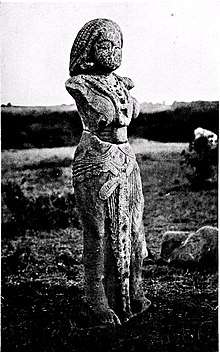
The three sites of Bharhut, Sanchi, and Mathura, have yielded huge numbers of Yakshi figures, most commonly on the railing pillars of stupas. These show a clear development and progression that establishes certain characteristics of the Yakshi figure such as her nudity, smiling face and evident (often exaggerated) feminine charms that lead to their association with fertility. The yakshi is usually shown with her hand touching a tree branch, and a sinuous pose, Sanskrit tribhanga, thus some authors hold that the young girl at the foot of the tree is based on an ancient tree deity.[4]
The ashoka tree is closely associated with the Yakshini mythological beings. One of the recurring elements in Indian art, often found at gates of Buddhist and Hindu temples, is a Yakshi with her foot on the trunk and her hands holding the branch of a stylized flowering ashoka or, less frequently, other tree with flowers or fruits. As an artistic element, often the tree and the Yakshi are subject to heavy stylization.
Some authors hold that the young girl at the foot of the tree is based on an ancient fertility symbol of the Indian Subcontinent.[4] Yakshis were important in early Buddhist monuments as a decorative element and are found in many ancient Buddhist archaeological sites. They became Salabhanjikas (sal tree maidens) with the passing of the centuries, a standard decorative element of both Indian sculpture and Indian temple architecture.[5]
The sal tree (Shorea robusta) is often confused with the ashoka tree (Saraca indica) in the ancient literature of the Indian Subcontinent.[6] The position of the Salabhanjika is also related to the position of Queen Māyā of Sakya when she gave birth to Gautama Buddha under an asoka tree in a garden in Lumbini, while grasping its branch.[5]
Yakshis in Jainism
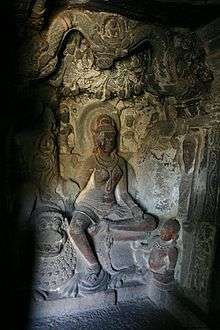
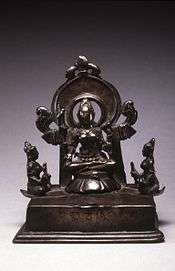
In Jainism, there are twenty-four yakshis, including Chakreshvari, Ambika, and Padmavati, who are frequently represented in Jain temples.[7] The names according to Tiloyapannatti (or Pratishthasarasangraha) and Abhidhanachintamani are:
- Chakreshvari
- Rohini, Ajitbala
- Prajnapti, Duritari
- Vajrashrankhala, Kali
- Vajrankusha, Mahakali
- Manovega, Shyama
- Kali, Shanta
- Jwalamalini, Mahajwala
- Mahakali, Sutaraka
- Manavi, Ashoka
- Gauri, Manavi
- Gandhari, Chanda
- Vairoti, Vidita
- Anantamati, Ankusha
- Manasi, Kandarpa
- Mahamansi, Nirvani
- Jaya, Bala
- Taradevi, Dharini
- Vijaya, Dharanpriya
- Aparajita, Nardatta
- Bahurupini, Gandhari
- Ambika or Kushmandini
- Padmavati
- Siddhayika
It is offensive, unacceptable and sinful to describe the physical features of Yakshini Padmavati Devi or any other goddess angel in Jainism religion with words like voluptuous, spherical breasts, etc in the above article. We never describe Mother Mary in the above manner as it is offensive. So please remove this offensive description and treat any angel or goddess with respect.
Yakshis in modern literature
In the horror fictions in South India, especially in Malayalam literature, Yakshis are mostly not considered benevolent. They are portrayed as alluring men and finally killing them. The following are the prominent fiction characters.
Kalliyankattu Neeli
One of the most famous legendary stories of Yakshis in Kerala is that of Kalliyankattu Neeli, a powerful demoness who was fabled to have finally been stopped by the legendary Christian priest Kadamattathu Kathanar. The Yakshi theme is the subject of popular Keralite tales, like the legend of the Yakshi of Trivandrum, as well as of certain movies in modern Malayalam cinema.
Mangalathu Chiruthevi
Another lesser known Yakshi is Mangalathu Chiruthevi also known as Kanjirottu Yakshi. She was born into a Padamangalam Nair tharavad by name Mangalathu at Kanjiracode in South Travancore. She was a ravishingly beautiful courtesan who had an intimate relationship with Raman Thampi, son of King Rama Varma and rival of Anizhom Thirunal Marthanda Varma.[8]
Mangalathu Chiruthevi was infatuated with one of her servants, Kunjuraman. Kunjuraman, a Pondan Nair (palanquin-bearer), was a fair, tall, well-built and handsome young man. She and her brother Govindan used to ride on Kunjuraman's back to nearby places. A predatory sadist, Chiruthevi enjoyed torturing Kunjuraman physically and mentally. She did everything possible to separate him from his wife.
In course of time, the unmarried Govindan and Kunjuraman became bosom friends. They often shared the same room. Chiruthevi was not quite comfortable with the growing fondness of her brother for her lover. But she did not act.
Chiruthevi hatched a plot and liquidated Kunjuraman's wife. Once Govindan was travelling on Kunjuraman's back when the former revealed the details of the plot. Days later, Kunjuraman strangled Chiruthevi to death when they were sharing a bed. Govindan winked at the crime and protected his beloved friend.
Chiruthevi was reborn as a vengeful Yakshi to a couple at Kanjiracode. She grew into a bewitching beauty within moments of her birth. Though she seduced many men and drank their blood, her heart was set on the handsome Kunjuraman. She told him that she was willing to pardon him if he married her. Kunjuraman flatly refused. The Yakshi channelised all her energies in tormenting him. Devastated, Kunjuraman sought the assistance of Mangalathu Govindan, who was a great upasaka of Lord Balarama. Govindan was for a compromise. He said that the Yakshi could have Kunjuraman for a year provided she conformed to three conditions. One, she must agree to be installed at a temple after one year. Two, after many years the temple will be destroyed and she must then seek refuge in (saranagati) Lord Narasimha for attaining moksham. Three, she must pray for Govindan and his relationship with Kunjuraman not only in their current birth but also in their subsequent births. The Yakshi swore upon 'ponnum vilakkum' that she would abide by all the three conditions. Thus the compromise formula worked.[9]
A year later, the Yakshi was installed at a Temple which later came to be owned by Kanjiracottu Valiaveedu.[9] The Temple does not exist anymore.
Sundara Lakshmi, an accomplished dancer and consort of HH Swathi Thirunal Rama Varma, was an ardent devotee of Kanjirottu Yakshi Amma.
After taking refuge in Lord Narasimha of Thekkedom, the Yakshi is now believed to be residing in Kallara B of Sri Padmanabhaswamy Temple.[10] The enchanting and ferocious forms of this Yakshi are painted on the south-west part of Sri Padmanabha's shrine.
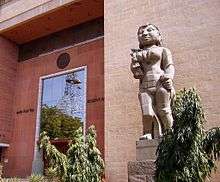
See also
References
- ↑ Huntington, John C. and Susan L., The Huntington Archive - Ohio State University , accessed 30 August 2011.
- ↑ "A History of Ancient and Early Medieval India: From the Stone Age to the 12th Century" by Upinder Singh, Pearson Education India, 2008
- 1 2 Magee, Mike (2006). "Yakshinis and Chetakas". Shiva Shakti Mandalam. Archived from the original on 9 April 2009. Retrieved 2 March 2016.
- 1 2 Zimmer, Heinrich Robert (1972). Campbell, Joseph, ed. Myths and Symbols in Indian Art and Civilization. Delhi: Princeton University Press. ISBN 978-81-208-0751-8.
- 1 2 Buddhistische Bilderwelt: Hans Wolfgang Schumann, Ein ikonographisches Handbuch des Mahayana- und Tantrayana-Buddhismus. Eugen Diederichs Verlag. Cologne. ISBN 3-424-00897-4, ISBN 978-3-424-00897-5
- ↑ Eckard Schleberger, Die indische Götterwelt. Gestalt, Ausdruck und Sinnbild Eugen Diederich Verlag. Cologne. ISBN 3-424-00898-2, ISBN 978-3-424-00898-2
- ↑ Vasanthan, Aruna. "Jina Sasana Devatas". Tamil Jain. Archived from the original on 27 October 2009. Retrieved March 2, 2016.
- ↑ Kaimal, Kesava. 'Thekkan Thiruvithamkurile Yakshikal'. Srinidhi Publications, 2002.
- 1 2 Nair, Balasankaran. 'Kanjirottu Yakshi'. Sastha Books, 2001.
- ↑ Bayi, Aswathi Thirunal Gouri Lakshmi. 'Sree Padmanabha Swamy Temple' (Third Edition). Bharatiya Vidya Bhavan, 2013.
- ↑ "Anecdote 3: Of Art, Central Banks, and Philistines". Reserve Bank of India. Retrieved March 2, 2016.
External links
| Wikimedia Commons has media related to Yaksha. |
